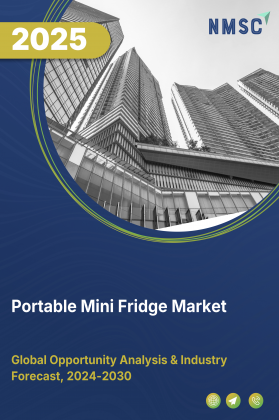
Household Induction Market by Type (Built-in Induction Cooktops and Free-Standing Cooktops), by Application (Household and Commercial) and by Distribution Channel (Offline and Online) – Global Opportunity Analysis and Industry Forecast 2024-2030
Market Definition
The Household Induction Market size was valued at USD 13.12 billion in 2023 and is predicted to reach USD 19.78 billion by 2030 with a CAGR of 6.04% from 2024-2030. Household induction, also known as induction cooktops refers to a type of cooking technology which uses electromagnetic induction for heating cookware utensils. These induction cooktops are becoming increasingly popular in the market due to their energy efficiency, performance, and safety. The rise in fuel expenses for conventional gas cooktops, as well as the growing trend of modular kitchens due to the comfort and safety benefits, are driving the household induction cooktops market.
Induction cooktops are often priced at a premium compared to traditional stoves, which can lead to higher profit margins for businesses. The market is being driven by an increase in the number of residential and non-residential development projects, as well as a rise in the number of restaurants and eateries.
Advent of advanced technologies, such as IoT devices can be used to create innovative kitchens or I-Kitchens that improve safety and efficiency in the kitchen. Wi-Fi connectivity enables real-time monitoring of the gas hob, including safety features such as gas leakage detection and automatic shut-off. For example, smart induction cookers often come equipped with advanced safety mechanisms such as automatic shut-off in case of overheating and child safety locks.
Market Dynamics and Trends
Rising awareness towards the benefits of induction cooktops such as energy-efficient induction stoves among the consumers globally drives the growth of household induction market. Some government associations are promoting the use of induction cooktop as a way to reduce energy consumption. According to a study by Energy Star (trusted certification program developed by the U.S. Environmental Protection Agency (EPA)), the per unit efficiency of induction cooktops is about 5-10% more efficient than conventional electric stoves and three times more efficient than gas stoves. Thus, the promotion of induction cooktops by some government associations to reduce energy consumption is boosting the market growth globally.
Also, increasing environmental benefits towards the use of induction cooktops which produces less greenhouse gas emissions is driving the market growth. These cooktops are more environment friendly as they use the electricity from renewable source of energy. For instance, in February 2023, Government of India launched a solar-power indoor cooking system that highlights the importance of green and clean cooking solution. Thus, induction cooktop has the potential to bring ideal choice for clean, energy-efficient cooking in the country.
Moreover, growing demand for induction cooktops in modular kitchens due to their energy efficiency, precision, and safety features is driving the growth of household induction market. According to the U.S. Department of Energy (DOE), a survey conducted by Consumer Reports in June 2022, almost 70% of population said that they would consider the use of induction cooktops for their modular kitchen appliances. These induction cooktops are up to three times more efficient than gas stoves and 10% more efficient than conventional electric stoves thereby resulting in lower energy costs and reduce its overall maintenance.
However, high rate of expenditure and power supply & voltage requirements towards the induction cooktops over traditional electric or gas in the developing and under-developed countries is restraining the household induction market growth. On the contrary, increasing integration towards smart home technologies such as voice control and remote monitoring which makes them more convenient and appealing to consumers. This is expected to create significant opportunity growth for the market.
Market Segmentation and Scope of Study
The household induction market is segmented on the basis of type, application, distribution channel, and region. On the basis of type, the market is categorized into built-in induction cooktops and free-standing cooktops. On the basis of application, the market is classified into household and commercial. On the basis of distribution channel, the market is bifurcated into offline and online. The offline market is further divided into hypermarkets/supermarkets, specialty store, and others. Regional breakdown and analysis of each of the aforesaid segments includes regions comprising of North America, Europe, Asia-Pacific, and Rest of the World (RoW).
Geographical Analysis
North America holds the dominating share of household induction market during the forecast period. This is due to the pandemic's focus on health impacts, the region is getting uprise increase in acceptance towards self-cooking as a medium of cookery. According to a survey by Bosch in 2021, over 60% of Americans adopted the necessity of cooking during the pandemic, in which 27% realized the need for better cooking appliances such as induction stoves in the region.
Also, the presence of prominent players such as GE Appliances, Whirlpool Corporation, and others plays a major role in the growth of the market. For instance, in January 2023, GE Appliances launched a new range of induction cooktops with technology added features which can be accessed through apps on smart phones. This technology allows consumer to decide the temperature of the burner for optimal consistency and performance. It is operated through SmartHQ app which allows its user to cook different types of food such as pancakes and fried food items.
On the other hand, Asia-Pacific is considered fastest growing region where the market is analyzed across India, China, Japan, and rest of the APAC region. It is based on the fact that the growing demand for energy-efficient and time-saving cooking appliances such as induction cooktops and stoves over the region is propelling the overall market growth.
For instance, in May 2023, TTK Prestige launched Double Induction Cooktop (PDIC 3.0) which is designed to meet the growing demand for energy-efficient solutions in modern kitchens. The PDIC 3.0 Double Induction Cooktop incorporates a unique power saver technology that intelligently adjusts the temperature and power output based on the size of the cooking vessel’s base diameter, conserving energy and minimizing heat wastage.
Also, the growing adoption of smart induction cooktops due to energy concerns among the rising population over the region. For instance, in August 2021, Samsung Electronics launched smart induction cooktop which is industry’s first cooktop recognized with energy efficient and lower emission rate in the product portfolio. This induction cooktops are approximately 5%-10% more efficient where an integrated annual energy consumption is less than or equal to 125 kWh per year.
Competitive Landscape
The household induction market includes several market players including LG Electronics, Whirlpool Corporation, Panasonic Holdings Corporation, TTK Prestige Ltd., Robert Bosch GmbH, Koninklijke Philips N.V., Miele, Smeg S.p.A, Fisher & Paykel Appliances Ltd, Sub-Zero Group, Inc. and others. These market players are opting various strategies such as product launches to maintain their dominance in the global household induction market.
For instance, in August 2023, LG Electronics launched its new built-in kitchen package including induction hob, oven, dishwasher, and others. This induction mob comes with downdraft and hood ventilation system located in the centre of the cooking surface.
For instance, in January 2023, Miele launched KM7000 induction cooktops which comes with added features including sleek design, easy to clean, and more energy efficient towards cooking technology. These models are available with connectivity function with which the ventilation hood can be controlled by the cooktop.
Key Benefits
-
The report provides quantitative analysis and estimations of the household induction market from 2024 to 2030, which assists in identifying the prevailing market opportunities.
-
The study comprises a deep-dive analysis of the household induction market including the current and future trends to depict prevalent investment pockets in the market.
-
Information related to key drivers, restraints, and opportunities and their impact on the household induction market is provided in the report.
-
Competitive analysis of the players, along with their market share is provided in the report.
-
SWOT analysis and Porters Five Forces model is elaborated in the study.
-
Value chain analysis in the market study provides a clear picture of roles of stakeholders.
Key Market Segments
By Type
-
Built-in Induction Cooktops
-
Free Standing Cooktops
By Application
-
Household
-
Commercial
By Distribution Channel
-
Offline
-
Hypermarkets/Supermarkets
-
Specialty Stores
-
Others
-
-
Online
By Region
-
North America
-
The U.S.
-
Canada
-
Mexico
-
-
Europe
-
The UK
-
Germany
-
France
-
Italy
-
Spain
-
Denmark
-
Netherlands
-
Finland
-
Sweden
-
Norway
-
Russia
-
Rest of Europe
-
-
Asia Pacific
-
China
-
Japan
-
India
-
South Korea
-
Australia
-
Indonesia
-
Singapore
-
Taiwan
-
Thailand
-
Rest of Asia Pacific
-
-
RoW
-
Latin America
-
Middle East
-
Africa
-
Key Players
-
LG Electronics
-
Whirlpool Corporation
-
Panasonic Holdings Corporation
-
TTK Prestige Ltd.
-
Robert Bosch GmbH
-
Koninklijke Philips N.V.
-
Miele
-
Smeg S.p.A
-
Fisher & Paykel Appliances Ltd
-
Sub-Zero Group, Inc.
REPORT SCOPE AND SEGMENTATION:
|
Parameters |
Details |
|
Market Size in 2023 |
USD 13.12 Billion |
|
Revenue Forecast in 2030 |
USD 19.78 Billion |
|
Growth Rate |
CAGR of 6.04% from 2024 to 2030 |
|
Analysis Period |
2023–2030 |
|
Base Year Considered |
2023 |
|
Forecast Period |
2024–2030 |
|
Market Size Estimation |
Billion (USD) |
|
Growth Factors |
|
|
Countries Covered |
28 |
|
Companies Profiled |
10 |
|
Market Share |
Available for 10 companies |
|
Customization Scope |
Free customization (equivalent to up to 80 working hours of analysts) after purchase. Addition or alteration to country, regional, and segment scope. |
|
Pricing and Purchase Options |
Avail customized purchase options to meet your exact research needs. |




















 Speak to Our Analyst
Speak to Our Analyst

























